AE2 Cl-/HCO3- exchanger is required for normal cAMP-stimulated anion secretion in murine proximal colon
- PMID: 20110461
- PMCID: PMC2853300
- DOI: 10.1152/ajpgi.00178.2009
AE2 Cl-/HCO3- exchanger is required for normal cAMP-stimulated anion secretion in murine proximal colon
Abstract
Anion secretion by colonic epithelium is dependent on apical CFTR-mediated anion conductance and basolateral ion transport. In many tissues, the NKCC1 Na(+)-K(+)-2Cl(-) cotransporter mediates basolateral Cl(-) uptake. However, additional evidence suggests that the AE2 Cl(-)/HCO(3)(-) exchanger, when coupled with the NHE1 Na(+)/H(+) exchanger or a Na(+)-HCO(3)(-) cotransporter (NBC), contributes to HCO(3)(-) and/or Cl(-) uptake. To analyze the secretory functions of AE2 in proximal colon, short-circuit current (I(sc)) responses to cAMP and inhibitors of basolateral anion transporters were measured in muscle-stripped wild-type (WT) and AE2-null (AE2(-/-)) proximal colon. In physiological Ringer, the magnitude of cAMP-stimulated I(sc) was the same in WT and AE2(-/-) colon. However, the I(sc) response in AE2(-/-) colon exhibited increased sensitivity to the NKCC1 inhibitor bumetanide and decreased sensitivity to the distilbene derivative SITS (which inhibits AE2 and some NBCs), indicating that loss of AE2 results in a switch to increased NKCC1-supported anion secretion. Removal of HCO(3)(-) resulted in robust cAMP-stimulated I(sc) in both AE2(-/-) and WT colon that was largely mediated by NKCC1, whereas removal of Cl(-) resulted in sharply decreased cAMP-stimulated I(sc) in AE2(-/-) colon relative to WT controls. Inhibition of NHE1 had no effect on cAMP-stimulated I(sc) in AE2(-/-) colon but caused a switch to NKCC1-supported secretion in WT colon. Thus, in AE2(-/-) colon, Cl(-) secretion supported by basolateral NKCC1 is enhanced, whereas HCO(3)(-) secretion is diminished. These results show that AE2 is a component of the basolateral ion transport mechanisms that support anion secretion in the proximal colon.
Figures


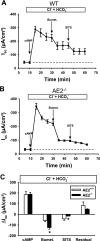

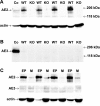
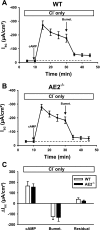
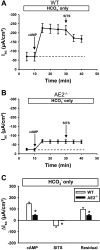
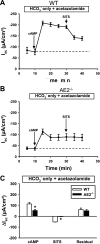
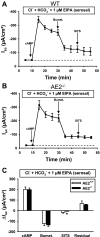
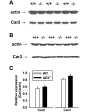
References
-
- Alexander RT, Grinstein S. Na+/H+ exchangers and the regulation of volume. Acta Physiol (Oxf) 187: 159–167, 2006 - PubMed
-
- Alper SL, Rossmann H, Wilhelm S, Stuart-Tilley AK, Shmukler BE, Seidler U. Expression of AE2 anion exchanger in mouse intestine. Am J Physiol Gastrointest Liver Physiol 277: G321–G332, 1999 - PubMed
-
- Alrefai WA, Tyagi S, Nazir TM, Barakat J, Anwar SS, Hadjiagapiou C, Bavishi D, Sahi J, Malik P, Goldstein J, Layden TJ, Ramaswamy K, Dudeja PK. Human intestinal anion exchanger isoforms: expression, distribution, and membrane localization. Biochim Biophys Acta 1511: 17–27, 2001 - PubMed
-
- Alvarez BV, Kieller DM, Quon AL, Robertson M, Casey JR. Cardiac hypertrophy in anion exchanger 1-null mutant mice with severe hemolytic anemia. Am J Physiol Heart Circ Physiol 292: H1301–H1312, 2007 - PubMed
-
- Bachmann O, Reichelt D, Tuo B, Manns MP, Seidler U. Carbachol increases Na+-HCO3− cotransport activity in murine colonic crypts in a M3-, Ca2+/calmodulin-, and PKC-dependent manner. Am J Physiol Gastrointest Liver Physiol 291: G650–G657, 2006 - PubMed
Publication types
MeSH terms
Substances
Grants and funding
LinkOut - more resources
Full Text Sources
Molecular Biology Databases
Miscellaneous

